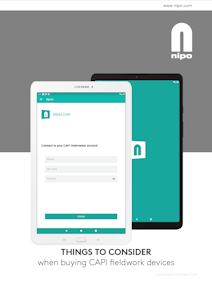Nfield CAPI is designed to run on Android tablets and phones. With so many different Android devices to choose from it is good to understand the considerations that are of importance when making the decision to go for one device or the other.
And with so many differences in usage, there is no device that is best for everyone. Which device is best suited for you depends completely on the kind of surveys that you run, the environment in which your interviewers work, how you want to depreciate your devices and many more factors. This document tries to help you identify some of the choices you will need to make when selecting a device to support your face2face interviewing business.
Nfield CAPI device recommended specs
Nfield CAPI cannot run on any Android device. Some devices are so cheap, that they just do not have enough processing or memory power to run Nfield interviews. Also manufacturers sometimes experiment with the specs of their machines with the result that they run Android but not all the apps from the app store.
Make sure that you test the devices that you intend to use for fieldwork before you buy them. Ask your supplier for a test machine, download the Nfield CAPI app and perform a test interview. If this works, and the speed is to your liking, order the devices; if not, then you know that this device is not for you.
To use the latest Nfield app and templates, NIPO recommends that you use Android devices with these specs:
| Minimum specs when using existing hardware: | Recommended specs when buying new devices: | |
| Android version: | 13 | 16 (or 15 with the option to later upgrade to 16) |
| Processor: | Quad core | Octa core |
| Memory: | 2GB RAM | 4GB RAM |
| Storage: | 32GB | 64GB |
What kind of surveys are you going to run?
Although you can use Nfield CAPI on both tablets and smart phones, the types of surveys that you want to run on Nfield might drive the choice for a typical device. If your surveys are very media heavy because you use a lot of show cards or video, you will probably consider 10” tablets to be the most suited device. If you are mainly doing quick exit polls a 4” or 5” smart phone might be your device of choice. Whichever device you choose, think carefully about all the types of surveys that you would like to run on these devices and not just about the project at hand. This prevents that you buy devices only for this one project that you then cannot use for other projects.
Where and how will the devices be used?
It makes a big difference whether you are conducting interviews on-the-street or in-the-home. On-the-street you might have to deal with unpredictable weather conditions or direct sunlight, whereas in-the-home interviews tend to be much longer in length and hence the device ergonomics become more important. We advise that you take these things into consideration when buying your device. You are strongly recommended to thoroughly test if the device is suitable for your interviewers before bulk purchasing devices for your fieldwork department(s).
On-the-street interviewing
When working outside you will need to factor in weather conditions. Especially direct sunlight can render tablets useless because of screen glare or a screen backlight that is just not powerful enough. You can use protective screen stickers that reduce glare but against poor backlight not much can be done. When you expect your interviewers to work in wet or dusty conditions make sure you select devices that are water proof. Many manufacturers nowadays have models in which the openings are covered to prevent water or dust damage.
Extended holding of the device
When your interviewers need to hold the device in their hands for an extended period of time, you might consider buying ergonomic sleeves for the tablets that protect the tablet and make it easy for the interviewer to hold and carry. If your interviewers are working much in the home of the respondent you might want to consider a sleeve that can be used as a standard or even one that comes with an integrated keyboard for easier typing.
Working in unsafe situations
Tablets and smart phones are objects of desire. Not everyone is able to afford these devices so they are prone to theft. If you know that your interviewer is going to work in a potentially unsafe situation make sure they can hide the tablet when walking on the street or choose a deliberately less appealing device. Make sure your interviewer does not become an unnecessary victim.
Mobile network or wifi only?
The Nfield CAPI app can sync with the Nfield server using mobile network or wifi. It is up to you to decide if you want to carry the extra cost involved with mobile connectivity. When deciding this you should take into consideration how easy your interviewers can access wifi, how quick you want access to the survey outcome, how often you need them to sync quotas etcetera.
When choosing a device you have the choice between wifi enabled devices or 5G enabled devices. The first only supports wifi, the latter both wifi and mobile networks. This does not mean that you need a mobile data subscription with a 5G enabled device; it only means that you can use such a subscription with that device. If you are not sure yet about using 5G we advise that you first buy a limited set of mobile network enabled devices and decide based on your experience in field about which type of connectivity you really need. Although 5G enabled devices are more expensive, in this way you won’t end up with a set of wifi only devices when you find that you do need mobile data connectivity.
Smart-pen or not?
Is it worth investing in a smart-pen or not? The answer is not the same for everyone. For most research you won’t need a smart-pen; your interviewers click only on buttons. Fingers are perfectly suited to that task. However, if you are based in China, Japan or any other country where they use a more elaborate character type set, a pen might prove valuable as keyboard input will be drawn on the keypad rather than typed.
Also, if you require interviewers or respondent to create detailed drawings or require them to sign off on their work a smart-pen might prove a valuable addition. In all other cases a smart-pen is probably an extra that you won’t need. If you do supply your interviewers with a smart-pen, make sure it is physically attached to the tablet or the tablet’s sleeve, as a pen is easily lost and often expensive to replace.
Battery life
One of the things you really do not want is that your interviewer is working in field and the battery suddenly dies. Make sure the tablet you are using has at least a factory stated battery life that is 125% of what you would need in field. So if your interviewers on average work 6 hours per day, make sure the stated battery life is at least 7.5 hours. Be aware that the stated maximum battery life is valid for use with minimum backlight. Unfortunately most tablets do not allow you to replace the battery. As almost all batteries degrade over time, you might consider equipping interviewers with a mobile power supply that functions as a portable battery.
Expected device lifetime
With the average tablet costing between $250 and $650 it is a worthwhile question to ask yourself how long you expect a tablet to last in field. With PC’s many market research companies use a 3 to 4 year depreciation scheme. For tablets and smart phones you might consider reducing this to 2 years. Not only because tablets are cheaper, but also because the specs are changing so quickly a 2 year old tablet might look outdated after this period.
Especially when you consider buying a device that is not running on the latest Android OS, do take into account that life span will be shorter.
If looking outdated is not a problem, you might go the other direction and look for a durable device that will last 4 years or even more. In that case consider the more expensive ruggedized type of tablets and smart phones that are used at construction sites. These devices are shock proof, water proof, dust proof, can be used in direct sunlight and come with replaceable batteries. But they also come with a much higher price tag that can easily exceed $1,000.
A question you need to ask yourself is whether you want to insure your devices. Annual insurance costs are often around 20% of the value of the device. This means that on a company level you will need to claim 20% of the machines in a given year as damaged/broken/lost to break-even. When you have only a limited number of devices it is often a smart idea to have insurance as 1 or 2 broken devices can have a big impact on the total cost of ownership, but for a larger field force it is often cheaper to repair or replace broken devices at your own expense than to have the devices insured.
Many manufacturers offer a standard one-year warranty on their products. In many cases it is possible to buy an additional one-year warranty. Before you consider this offer, check your local legislation on warranty as several countries require manufacturers to give a two-year warranty by law. If you do not have two-year warranty by law, the arguments for deciding about extended warranty are the same as for insurance.
Device management software
Have you thought about how you will secure and manage the devices? You probably do not want your interviewers using the tablet for other purposes than interviewing. And when the device gets lost or stolen you will want the ability to retrieve it, lock it down or even remote wipe content from it. There are some really good out of the box solutions that you can use to manage these things for you. Which solutions suits you best depends on your needs and on the amount of money you are willing to spend on a solution.
Often the device manufacturer itself has a free built in service that allows you to register devices and trace it or wipe it remotely in case of loss. These services assume you are the owner of the device so they include no features for content or usage management. If you want these features you will be looking for Mobile Device Management (MDM) solutions that allow you to control what users can do on a device and even completely manage your devices remotely. These extra features do come at a cost though; how much depends on what solution you choose, but expect to pay around $20 per device annually for an MDM solution.
Some MDM solutions allow you to whitelist websites that may be visited with the device. Although a very handy feature, it may also cause problems when using public wifi. If you allow your interviewers to use public wifi networks, make sure that you have whitelisted the login pages of the WiFi networks they are most likely to use. Otherwise they won’t be able to connect to the Internet if the wifi network requires a username and/or password.
Updating the Android version
Google releases regular updates of its Android operating system. Many manufacturers distribute these updates to devices sold in the years before. During the lifecycle of a fieldwork device you can expect to receive one or more updates of the device’s software version. We advise that you only update your devices to a newer Android version after having thoroughly tested it on at least one device.
When you are using Google’s own tablets it is especially important that your test extensively before you update them as Google often pushes out breaking changes without prior notification. Other hardware suppliers typically update two to three months after the new Android version is launched, giving NIPO enough time to adapt the Nfield CAPI app to any breaking changes a new Android version might introduce.
However, because each tablet model has its own Android ‘version’, it is impossible for NIPO to test all devices and Android updates that become available. It is not possible to have the device automatically update the Android version. It needs a manual action from the device user or you can push it using MDM software. When an update for the Android version becomes available for your fieldwork devices the person working with this device will be notified of the update. If you want to prevent them from installing the Android update, make sure your devices are managed using MDM software.
Nfield CAPI app update strategy
Over the years we have developed and supported numerous Nfield CAPI apps. As you can imagine we cannot support all versions indefinitely. With this new strategy we limit the number of Nfield CAPI app versions out in the field.
This will not only save time we spend on investigating problems on older versions of the Nfield CAPI app, but we will use that time to add new features and strengthen the current options that are available. This will also encourage our customers to upgrade to the latest version of the Nfield CAPI app and start using the new features we are continuously developing.
We will update the minimum supported version every quarter. So please keep an eye out on the communications we share about this subject. All our communications can also be found in the release notes section in the ‘Knowledge centre’ in Nfield Manager. If you are still using the classic Nfield Manager, communication can be found in the customer section of our website.
Minimum supported Nfield CAPI app
As of 1 September 2025, the minimum version for the Nfield CAPI app will be 2.32.
Interviewing devices that are running a version of the app that is lower will no longer be able to synchronize. As a domain administrator it is important to act and share this news within your organization, so it gets to the attention of the people that should take action.
If you are working with older Nfield CAPI apps that will stop being supported, now is the time to ensure business continuity by keeping CAPI devices updated with the required minimum app versions.
Supported Android versions
We align our development efforts with the support Google gives on their versions of the Android mobile operating system. The new versions of the Nfield CAPI app will only be available for Android platforms that are still supported by Google.
This means that you will not be able to install or update the Nfield CAPI app from Google Play on a device that runs a version of Android that is no longer supported by Google. At this moment, this applies to all devices that are running an Android version older than Android 13.
Download this information
Click here to download this information as a pdf document.


